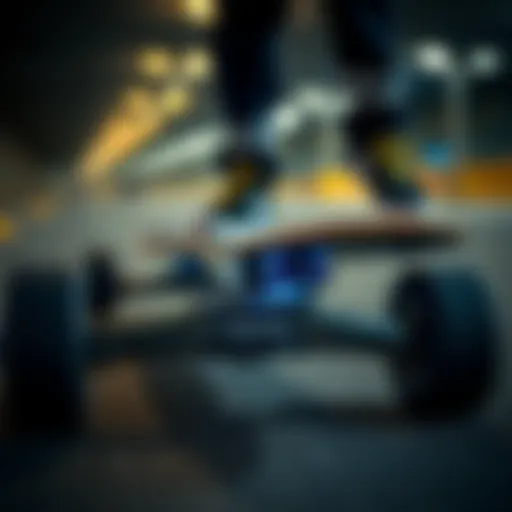Choosing the Right Skateboard Wheels for Optimal Performance
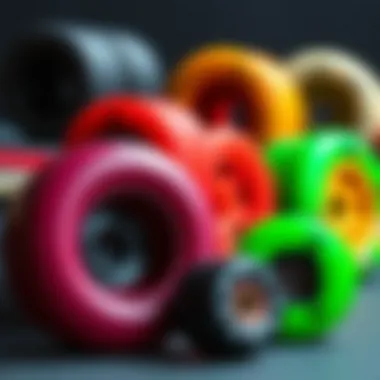
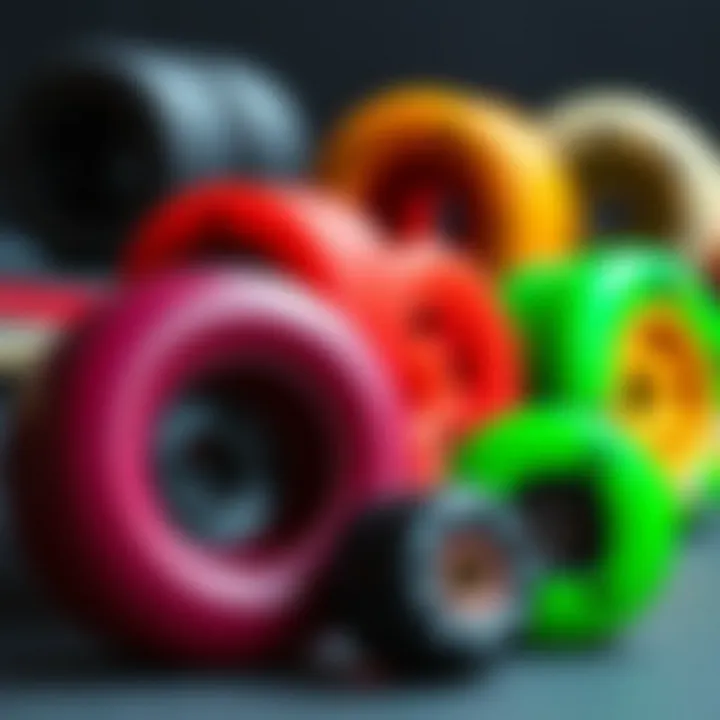
Intro
When it comes to skateboarding, the wheels you choose can make or break your ride. Many skaters, especially those just mulling into the sport, often overlook this significant aspect. The right wheels can greatly enhance performance, ride comfort, and overall enjoyment. Whether you're cruising down the street, pulling tricks in the park, or racing downhill, understanding the ins and outs of skateboard wheels is essential.
In this guide, we'll dissect the key factors in choosing the perfect wheels for your skateboard. We’ll cover aspects like wheel size, durometer, material, and intended use, all of which play a pivotal role in your riding experience. From mastering basic tricks to tackling advanced maneuvers, selecting appropriate wheels aids not just in performance but skill development as well.
This exploration is designed not just for beginners but also seasoned pros who are keen to refine their setups or adapt to new styles. Understanding these dynamics will enhance not just your skills on the skateboard, but also the joy that comes with each ride. So let’s roll into the core elements that define skateboard wheels and how to make the best pick for your style.
Understanding Skateboard Wheels
Choosing the right skateboard wheels is more than just picking a color or a brand; it’s essential for optimizing performance and comfort. The wheels are critical to how you experience the ride. They influence everything from speed and stability to your ability to execute tricks or simply cruise around the city. Understanding skateboard wheels empowers you to tailor your setup according to your specific needs—be it street skating, cruising, or hitting the ramps.
Definition and Function
Skateboard wheels are circular components designed to provide the necessary traction and balance when riding. Their primary function is to facilitate smooth movement over surfaces while ensuring stability for tricks and sharp turns. Essentially, wheels are the point of contact between the skateboard and the ground, making them pivotal for any skater. Without the right wheels, even the most skilled skateboarder may struggle to find comfort and control.
Components of a Skateboard Wheel
When diving into skateboard wheels, it’s important to understand their three core components: the hub, urethane, and core. Each part plays an integral role in the wheel’s performance and its interaction with the skateboarder.
Hub
The hub is the central part of the wheel where it attaches to the axle. Typically made from a harder plastic, its durability is crucial as it takes on significant pressure during tricks and daily rides. A prominent characteristic of hubs is their design, often featuring a bearing seat that fits most skateboarding styles. Hubs designed with precision molding tend to provide better fit and spin, offering a noticeable advantage in speed and control.
One unique feature of some hubs is their compatibility with specific bearing types, enhancing overall performance. Choosing a well-designed hub can greatly improve your skateboard's responsiveness, making it a beneficial choice for anyone serious about their skating.
Urethane
Urethane is the primary material used in skateboard wheels, favored for its durability and shock absorption properties. It allows for better grip and more comfortable rides, especially on rough terrain. Notably, the key selling point of urethane wheels is their ability to handle various surfaces without compromising the ride quality.
Unique to urethane wheels is their capacity to bounce back after compression, providing what many skaters describe as a “smooth glide.” Their performance might be less than ideal on slick surfaces, but when it comes to rough pavements or skate parks, urethane shines due to its high elasticity. Thus, it remains a popular choice among skaters across different disciplines.
Core
The core of the skateboard wheel refers to the interior structure that houses the bearings. It is often made of a more rigid material than the urethane, providing stability and strength to the wheel. Cores can significantly affect the overall weight distribution and balance of the skateboard, making their design crucial.
A key characteristic of high-quality cores is their ability to support larger diameters without compromising strength. This feature enhances durability while maintaining agility. Some cores are designed with ventilation holes, which help dissipate heat during intense skating sessions. This design can contribute to longer-lasting wheels, although such features can also slightly increase the weight. Therefore, skaters must consider the pros and cons when selecting cores for their wheels.
"When it comes to skateboard wheels, every component matters. A well-crafted hub, a resilient urethane, and a robust core can make all the difference in your ride."
Wheel Size and Its Impact
Choosing the right wheel size for a skateboard is an essential factor in determining how well the board performs in various settings. The diameter and width of a wheel directly affect speed, stability, and maneuverability. Often, skaters might not realize that these dimensions can dramatically change the riding experience, whether one is grinding rails, cruising the campus, or carving up the streets. In this section, we’ll breakdown the significance of wheel size and explore how different characteristics can enhance or hinder your skating prowess.
Influence of Diameter
Standard Sizes
Skateboard wheels generally fall into two main diameter categories—small and large. The common size for street and park skating wheels is about 50-54mm. These smaller wheels are nimble and allow better control during tricks, making them a go-to choice for street skaters. On the flip side, larger diameters, typically between 55-60mm, facilitate better speed and smoother rides over rougher surfaces. This characteristic makes them an ideal choice for cruisers and longboard enthusiasts.
One distinct feature of standard sizes is their adaptability. Smaller wheels are less forgiving when hitting bumps, but they allow for better trick execution. Larger wheels glide over cracks and gaps more smoothly, aiding in a comfortable ride. However, the trade-off is a potential loss in agility. Understanding how these standard sizes meet specific skating needs can guide you in tailoring your setup.
Choosing the Right Diameter
When it comes to selecting the right diameter, you must consider personal skating style and the terrain you'll frequently skate on. For instance, if you’re all about performing tricks at the skatepark, opting for a diameter around 52mm is generally advisable. This allows for a heightened sense of responsiveness.
Alternatively, if your sights are set on downhill racing or cruising around town, larger wheels around 57mm or more can offer a significant performance boost. A unique feature of this choice is the balance between comfort and performance. While larger wheels provide a smooth roll that might buffer against rougher terrains, they can feel clunky in certain trick-oriented situations.
Wheel Width Considerations
Narrow vs. Wide Wheels
Skateboard wheel width plays a crucial role in ride feel and performance, much like diameter. Narrow wheels, often ranging from 28-30mm, enable sharper turns and are favored in technical street skating—it’s easier to lock-in a grind. However, one must also consider the versatility of wider wheels. These can range anywhere from 30mm to over 40mm, offering improved stability and durability.
The key characteristic of narrow wheels is their agile nature. They help skaters remain light on their feet, which can be indispensable when landing complex tricks. However, they could present challenges in maintaining balance, especially when cruising downhill. Wide wheels add surface area, which enhances grip but can compromise the fluidity of tricks.
Effect on Stability and Speed
Stability and speed are highly influenced by the width of the wheels. Wider wheels tend to provide more grip, particularly when rounding corners. This characteristic makes them a popular choice for downhill racers and individuals seeking a stable ride.
While narrow wheels may be quicker in terms of speed due to their lighter weight and less surface area on the ground, the loss of grip can lead to potential wipeouts. Think of it this way: a skateboarder using wider wheels is akin to driving a car with high-friction tires, where a narrower version resembles tires meant for speed. Understanding how these features tie back to your desired activity will improve your wheel selection journey.
"The right wheel size isn’t just a preference; it’s about enhancing your skating experience. Consider both diameter and width carefully to find what best suits your style!"
To sum it up, wheel size exerts a huge impact on your overall skateboarding experience. Careful consideration of diameter and width will lead you down the path to finding the ideal wheels for your purpose and personal skating style.
Durometer: Hardness Matters
Understanding the durometer of skateboard wheels is fundamental for every skater aiming to enhance their riding experience. The hardness of a wheel can significantly influence performance characteristics such as grip, durability, and shock absorption. Hence, the right durometer not only matches the skater’s style but can also elevate the overall quality of the ride.
Understanding Durometer Ratings
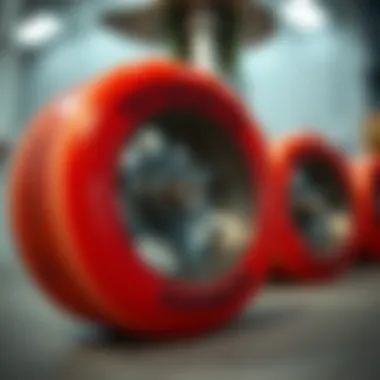
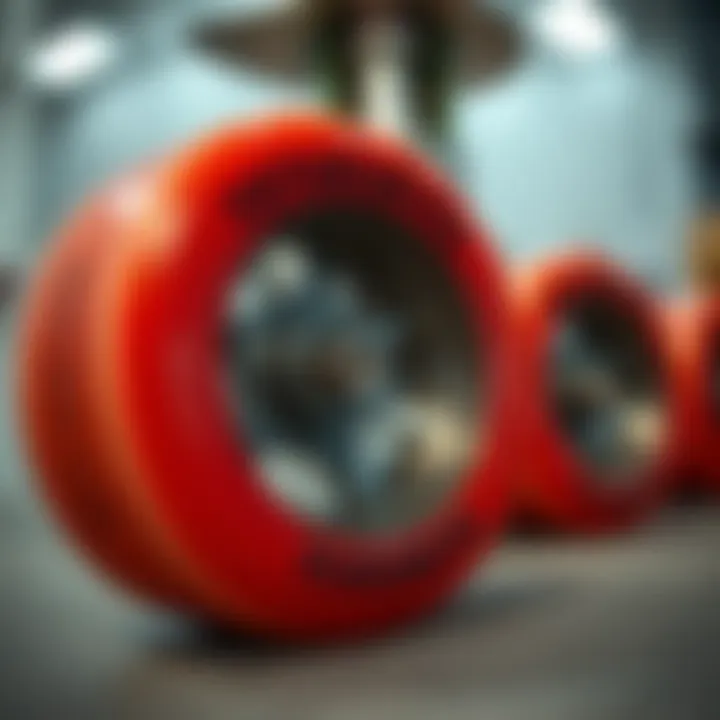
What the Numbers Mean
The durometer rating is a measure of the hardness of a material, in this case, the urethane used in skateboard wheels. Generally, this rating is expressed by the Shore A scale, which uses numbers ranging from about 78A to 101A. A higher number signifies a harder wheel. Most skateboard wheels fall within the 78A to 101A range, and this aspect is crucial because it directly impacts how a wheel responds on different surfaces.
- Key Characteristic of Durometer Ratings: The numeric values not only determine how stiff or soft a wheel feels but also influence the skater's experience in terms of speed and control.
- Unique Feature: Softer wheels (78A-87A) tend to grip well on rough surfaces, providing excellent shock absorption—an ideal choice for street skating with numerous obstacles. In contrast, harder wheels (88A-101A) excel in speed and slide ability on smooth, flat terrain.
For instance, if a skater often navigates through skate parks with smooth concrete, opting for harder wheels can lead to a faster, more exhilarating ride. Conversely, softer wheels might better serve someone traversing uneven urban areas where grip and comfort are paramount.
Choosing the Right Hardness Level
Selecting the appropriate durometer level enhances not just the performance but the skater's overall enjoyment. When choosing wheels, consider your primary skating environment and style. A durometer rating around 78A to 87A generally works well for beginners or those who perform tricks on uneven surfaces, while seasoned skaters might prefer ratings at or above 88A for a faster glide on smoother ground.
- Key Characteristic: Understanding one’s skateboarding style is pivotal.
- Advantages and Disadvantages: Choosing a softer wheel offers better control in urban terrains but may wear down quicker compared to harder wheels. On the flip side, harder wheels last longer and provide speed, albeit with less grip on rough surfaces.
Soft vs. Hard Wheels
When it comes to skateboard wheels, the debate between soft and hard wheels is as old as skateboarding itself. Both categories have their advantages and specific contexts where they shine. Let’s take a closer look:
Benefits of Softer Wheels
Softer wheels, generally rated from 78A to 87A, are known for their capacity to grip and absorb shocks efficiently. This aspect allows for a comfortable ride across uneven or rough terrains. Softer wheels can help skaters land tricks with greater ease, preventing potential injuries from hard landings.
- Why It Is a Popular Choice: Particularly for street skating, these wheels can flex to navigate curbs and cracks that may otherwise throw the rider off balance.
- Advantages/Disadvantages: The downside is that softer wheels can wear out more quickly on smooth surfaces, where their grip isn't as necessary.
Advantages of Harder Wheels
On the other end of the spectrum, harder wheels, rated between 88A to 101A, provide advantages like speed and longevity. These wheels are less likely to deform under pressure, making them ideal for smooth surfaces like skate parks.
- Why It Is Beneficial: They slide better and give skaters a faster experience, beneficial for performing tricks or racing scenarios.
- Unique Features: The trade-off with harder wheels is that they may lack the traction necessary for uneven surfaces, making them a poor choice for skaters who prefer street skating.
Overall, the choice between soft and hard wheels caters to individual skateboarding preferences and the environments where one typically rides. Understanding the nuances of durometer is crucial for making educated decisions that enhance performance and enjoyment.
Materials Used in Skateboard Wheels
Selecting the right material for skateboard wheels can influence everything from the ride feel to the longevity of your setup. The material directly impacts how well a skateboard performs on different surfaces and during varying styles of skating. In the realm of wheels, two key players emerge: urethane, the favored choice for a good reason, and a growing category of eco-friendly options. Understanding these materials is essential for any skateboarder seeking to enhance their riding experience.
Urethane: The Gold Standard
Why Urethane Is Preferred
Urethane has set the gold standard in skateboard wheel construction for various compelling reasons. For one, its unique blend of durability and shock absorption allows skaters to roll smoothly over diverse terrains. Urethane’s flexibility also enhances grip on surfaces, allowing you to carve and turn with more control than harder materials like plastic. Additionally, urethane wheels tend to wear down slower than their alternatives, making them a cost-effective choice in the long run.
The key characteristic that makes urethane the go-to material is its ability to conform to the riding surface. This feature enables better traction without sacrificing speed. Many skateboarders appreciate the feedback urethane provides while riding, giving a true feel for the ground beneath them, enhancing the connection between the skater and the board. In summary, urethane's properties serve as a cornerstone for today's skateboard wheels, establishing it as a popular and reliable choice.
Comparing Urethane with Other Materials
When looking at alternatives to urethane, you might find options like plastic or rubber. While these materials can sometimes be cheaper, they often lack the performance benefits essential for quality skating.
Comparing urethane with plastic wheels reveals significant differences: plastic wheels may slide too easily on smoother surfaces, lacking the necessary grip and durability. Also, their short lifespan means they end up quickly needing replacement, negating any upfront savings. On the other hand, rubber wheels, although providing a softer ride, often struggle on rougher surfaces due to excessive wear.
Urethane, in contrast, provides the ideal balance of durability and performance, ensuring skateboarders can focus on their tricks or cruising without worrying about their gear giving out.
Recycled and Eco-Friendly Options
Environmental Impact
With increasing awareness of environmental issues, some skateboard manufacturers are turning their sights to recycled materials. Using eco-friendly options for wheels represents a notable shift within the industry. These materials often utilize repurposed plastics or other sustainable elements, offering a green alternative to traditional wheels.
The key characteristic of eco-friendly options is how they reduce waste without compromising performance. Some might be skeptical about their effectiveness; however, many skateboards now utilize these materials successfully. Choosing these options not only supports sustainability but also encourages a more responsible skating attitude among users.
Performance Considerations
While focusing on the environmental impact, it’s crucial to discuss performance considerations of eco-friendly wheels. Although some recycled materials may not yet match urethane in flexibility and grip, advancements in technology are steadily bridging this gap. Many skaters enjoy the peace of mind that comes with knowing their wheels have less environmental footprint, without sacrificing too much on performance.
When selecting eco-friendly wheels, users need to consider the level of performance needed. They might find a wheel that meets most, if not all, of their needs while contributing positively to the environment. Ultimately, making informed choices about materials can lead to not only better skating experiences but also a positive impact on our planet.
Types of Skateboard Wheels
When selecting the appropriate wheels for your skateboard, understanding the various types is crucial. The type of wheel not only impacts the overall performance of the board but also significantly affects the rider’s experience. Different types of wheels cater to distinct skating styles, and knowing these distinctions helps in making a confident choice. Whether you're focused on street skating, cruising down the boardwalk, or tackling aggressive tricks, the wheel type plays a pivotal role in achieving optimal performance.
Street vs. Cruiser Wheels
Defining Street Wheels
Street wheels are specifically designed for the demands of urban terrain. One of the key defining features is their smaller diameter, typically hovering around 50 to 54 mm. This size allows for easier maneuverability, making it ideal for performing tricks and grinding on rails or ledges. A notable aspect of street wheels is their hardness; they usually fall within the 101A to 104A durometer range, providing a solid grip on smooth surfaces while offering enough durability to absorb impacts from jumps and tricks.
The concentrated rigidity of street wheels translates to precise control, which is a beneficial factor for trick-oriented riders. However, it’s vital to mention the trade-off: street wheels may not perform as well on rough surfaces. If you find yourself navigating cracked pavements and potholes, you might find these wheels a bit unforgiving.
Characteristics of Cruiser Wheels
Cruiser wheels, on the other hand, offer a different skating experience aimed at comfort. Their diameter typically ranges from 55 to 60 mm, giving them a larger surface area to effectively roll over rough terrains, cracks, and pebbles. A major characteristic of cruiser wheels is their softer urethane material, which usually has a durometer rating of around 78A to 87A. This softness allows them to absorb shocks, providing a smoother ride, especially during long stretches of cruising.
A unique feature of cruiser wheels is the ability to glide over obstacles with ease. This makes them a popular choice for skaters who prioritize a laid-back riding style rather than performing hardcore tricks. Nonetheless, softer wheels can shave off some speed on smoother surfaces, which might not be preferred by those looking to race or gain maximum velocity.
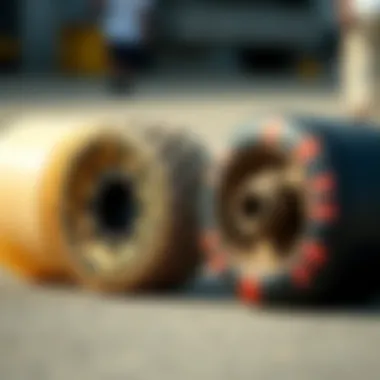
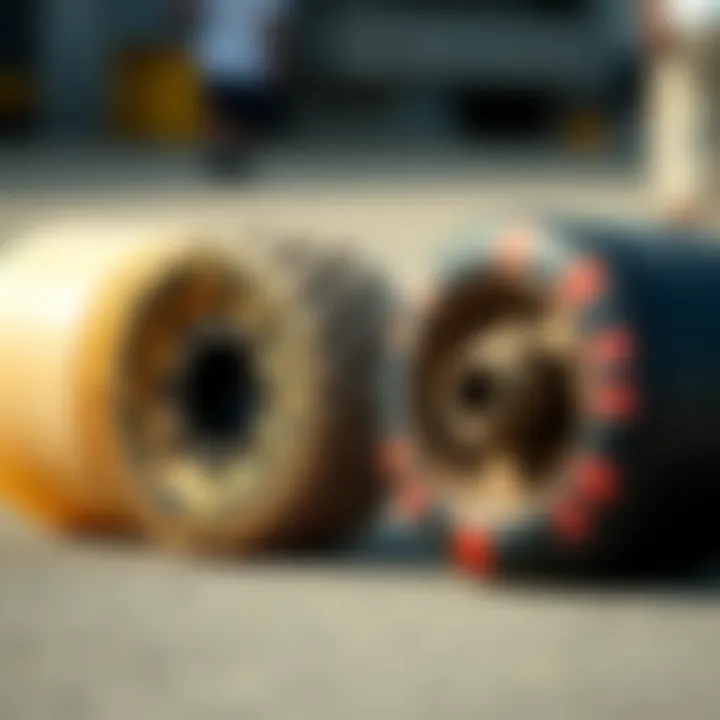
Aggressive vs. Longboard Wheels
Understanding Aggressive Designs
Aggressive wheels are tailored for skaters who engage in performing technical tricks and stunts. One important aspect of aggressive designs is the wheel's smaller size, generally around 50 to 52 mm, which facilitates tighter and quicker turns. The hardness of these wheels often falls between 88A to 100A durometer, allowing for greater responsiveness during trick execution. Skaters flying off ramps or landing on curbs benefit from the juxtapositional grip these wheels offer.
These aggressive wheels are beneficial for street and ramp settings but may not perform well during long-distance rides. Their design prioritizes control and impact resistance over comfort, making them less suitable for cruising.
Longboard Wheel Features
Longboard wheels present a stark contrast to their aggressive counterparts. Generally larger, typically ranging from 65 to 75 mm, longboard wheels are crafted for stability and smooth rolling. One of the key characteristics of longboard wheels is the softness, which can range from 77A to 83A. The larger diameter coupled with a softer durometer helps skaters maintain speed over various terrains, from steep hills to rough roads.
The unique feature of longboard wheels is the ability to sustain high speeds while providing a comfortable ride. This makes them popular for downhill skating or long-distance journeys. However, it’s worth considering that their larger size may hinder performance in trick-heavy scenarios.
Through understanding the distinctions among wheel types, skaters can better align their choices with their intended skate style and riding conditions, enhancing both performance and enjoyment on the board.
Skating Style and Wheel Selection
When it comes to skateboarding, selecting the right wheels isn't just a matter of matching colors or price. The type of skating you do has a decisive impact on the kind of wheels you should choose. Not all wheels perform the same way across different styles, be it street skating, park skating, or cruising. So, understanding your skating style is key to enhancing your overall experience on the board. It's like picking a pair of shoes; they need to fit your lifestyle as much as your feet.
Choosing Wheels for Tricks
Features for Street Skating
Street skating demands wheels that are not just robust, but also designed for precision. For street skating, you typically want wheels that are around 51-53mm in diameter and harder, usually falling in the range of 99A to 101A on the durometer scale. This hardness is key for ‘popping’ tricks like ollies or flips.
One of the quintessential characteristics of wheels for street is their response to surfaces. When you're hitting ledges, curbs, or rough pavement, you want your wheels to offer less grip, allowing for easier slides and grinds. However, this sacrifice in some traction pays off in terms of flip tricks and technical maneuvers. In practice, many skaters often find harder wheels give them that extra snappy feel when executing tricks.
Harder wheels mean more control for intricate tricks, while softer wheels can feel sluggish on technical setups.
Considerations for Park Skating
In contrast, park skating presents a different set of requirements. If you're spending time with transitions, bowls, or ramps, you might consider slightly larger wheels in the range of 55-60mm, often with a more forgiving durometer of about 90A to 95A. The bigger size helps with stability at speed, and the softer urethane means better grip on the transitions.
These wheels are designed to handle larger drops and smoother rides in the park, giving you that dreamy glide across surfaces like coping and spillways. However, the trade-off is that they may lack the agility needed for technical tricks. Young skaters must think carefully about this balance when setting up their decks for park skating.
Wheels Suited for Cruising
Cruising is an entirely different ball game. Here, comfort and ease are the names of the game. The wheels suited for cruising are usually wider and softer, helping absorb the bumps and irregularities of everyday streets. They operate better on a range of surfaces, allowing for a smoother ride whether you're navigating urban environments or just riding for fun.
Preference for Comfort
One of the primary characteristics of comfortable cruising wheels is their diameter, typically on the larger side, about 55-60mm or even more. This larger size helps you glide over cracks and skateparks without losing momentum or skidding. The softness, usually around 78A to 87A, offers a cushioned feel, allowing for a gentler ride. It’s this cushioning effect that reduces the vibration from the pavement and results in a materially nicer experience for leisurely rides. Hence its popularity amongst commuters and casual skaters.
Speed Requirements
However, cruising is not just about the bumps; speed is important too. When considering speed, you generally want wheels that offer a good balance between softness and hardness to maximize both comfort and velocity. Softer wheels can provide the grip needed to gain momentum, especially when stopping and starting, but they might slow down significantly on smooth terrain.
Opting for wheels in the range of 78A to 83A often strikes that sweet spot for those who want to cruise swiftly without sacrificing ease of navigation. The precise choice often narrows down to personal preference, though, with many cruisers settling on slightly harder wheels to maintain that zest and flip ability in their riding style. Balancing comfort against speed is crucial to finding that right fit.
Maintenance and Care of Wheels
Taking care of your skateboard wheels is crucial for ensuring a smooth ride and prolonging the life of your board. Skaters often underestimate the importance of maintenance, thinking that simply riding the board is enough. However, regular maintenance not only enhances performance, but also boosts safety. Just like a car requires oil changes and tire checks, your skateboard needs regular wheel care.
Regular Inspection
Identifying Wear and Tear
One significant aspect of maintaining skateboard wheels is the ability to identify wear and tear. This process involves looking for signs that the wheels aren’t performing at their best, which is essential for safety and optimal performance. Signs of wear might include flat spots, cracks, or uneven wear patterns on the wheels. Remember, if you spot any of these issues early, it could save you a nasty fall or an expensive replacement.
The key characteristic of wear and tear inspection is vigilance. Being aware of how your wheels are aging allows you to catch problems before they escalate. This is a no-brainer for anyone who wants to skate without worrying about unexpected blowouts or lack of grip.
It is beneficial since it instills a habit of checking your skateboard regularly, making it second nature. A unique feature of this practice is that it gives skaters a chance to familiarize themselves with the performance of their wheels over time, assessing what might need changing after a long session. However, neglecting this routine could lead to bigger issues down the line, resulting in injuries or damage to your setup.
Importance of Proactive Care
Proactive care is arguably one of the cornerstones of skateboard wheel maintenance. By taking the time to care for your wheels regularly, you can greatly improve their lifespan and your overall riding experience. When you’re mindful and take precautions, you’re less likely to run into excessive wear.
The defining characteristic here is anticipation. By anticipating what might go wrong, you can prevent issues before they arise. This proactive approach is beneficial because it saves money in the long run and keeps you in optimal skating condition.
A unique aspect of this principle is that it reflects a skater’s dedication to their gear. Taking a few minutes to inspect and care for the wheels can keep everything rolling smoothly for much longer. However, overdoing it can result in spending more time fixing than riding, which can be frustrating.
Cleaning Techniques
Keeping skateboard wheels clean is just as important as inspecting them. Dirty wheels can drastically affect how a skateboard performs, causing unnecessary drag and even affecting grip.
Recommended Cleaning Solutions
One key element of effective cleaning is selecting the right cleaning solutions. There are numerous products available specifically designed for cleaning skateboard wheels, but many skaters find that a simple mix of warm water and mild soap does wonders. Not only is this solution easy on the wallet, but it’s also safe for the urethane material of the wheels.
The beneficial characteristic of using gentle solutions is that it prevents damage. Using harsh chemicals can wear down the material, leading to cracks and overall deterioration. The unique feature of this approach is its accessibility; anyone can create a cost-effective cleaning solution at home without needing specialized products.


However, it’s essential to rinse thoroughly since leftover soap can leave residue that affects the wheels’ performance.
Tools for Effective Cleaning
Equipping yourself with the right tools can significantly enhance your wheel cleaning effort. Using a soft brush or an old toothbrush works relatively well for scrubbing the dirt off. It’s all about getting into the grooves without doing any harm to the wheels.
The most distinctive characteristic of using these effective tools is the ability to remove dirt effectively without scratching the wheel surfaces. This choice is beneficial because it makes cleaning both thorough and efficient. A unique approach is to use a dedicated wheel cleaning kit, which may include brushes designed specifically for this purpose.
On the downside, investing in multiple tools can become expensive, but think of it as an investment in the longevity of your setup.
Keeping in mind that maintenance doesn’t have to be a chore, regular checks and cleanings can turn your skateboard into a reliable companion for all your tricks and cruising adventures.
Common Questions and Misconceptions
Understanding the common questions and misconceptions surrounding skateboard wheels is crucial for both novice and seasoned riders. This section touches on some frequent queries that can often lead to confusion or misinformed decisions when selecting wheels. Addressing these questions not only demystifies the selection process but also helps enhance the overall skating experience.
Many skaters, particularly those new to the sport, may not fully appreciate how wheel characteristics affect performance. For instance, there’s often a misunderstanding about how wheel size influences speed or stability. By clarifying these misconceptions, skaters can make better choices that suit their riding styles and environments. Misunderstandings can lead to frustrations, such as choosing wheels that are not optimal for their intended use, or even worse, making a costly mistake in a purchase.
This section serves as a guide to navigate these muddy waters, ensuring that the rider's experience on the board is both enjoyable and efficient.
Understanding Wheel Roll and Speed
When it comes to skateboarding, the concept of wheel roll and speed is pivotal yet often misinterpreted. Many believe that bigger wheels automatically equate to faster skating. While it's true that larger wheels typically roll over obstacles more efficiently and maintain speed over uneven surfaces, this is not the whole story.
Factors affecting wheel roll include:
- Wheel Diameter: Larger diameter wheels tend to roll smoother over cracks and debris. However, they also require more energy to get them spinning from a stop.
- Urethane Quality: A higher quality urethane composition ensures a better grip and smoother ride. Lower quality wheels might slow a skater down due to increased friction.
- Wheel Durometer: This measures hardness. Softer wheels can deform slightly on impact, offering better grip and smoother ride, but may slow down more easily on flat surfaces.
In essence, while larger wheels can roll faster over rough terrain, they might not always be the best choice for technical street skating, where flicking your board and sharp turns are crucial. Decisions on wheel size should be made considering the skating environment alongside personal style and preference.
"Choosing the right wheel size shouldn’t just be about speed; consider the type of skating you do."
Dispelling Myths about Wheel Hardness
A common myth in the skateboarding community revolves around the misconception that harder wheels are universally better than softer ones. While the durometer, which measures hardness, plays a significant role in performance, the reality is that both soft and hard wheels have their specific advantages depending on the context of use.
Here are some key points to consider:
- Hard Wheels (typically rated above 101A) offer high speed and are preferable for smooth surfaces and tricks. They slide easily, making them ideal for street skaters who need to execute quick maneuvers.
- Soft Wheels (generally rated around 78A to 96A) absorb shock effectively, providing a comfortable ride on rough terrain. These wheels are preferred for cruising and for riders looking to put in many miles with minimal discomfort.
Skaters often fall into the trap of believing that only one type of wheel hardness can deliver optimal performance. However, understanding the intended skating style is essential. For example, park skaters may prefer harder wheels for tricks, while casual cruisers might stick with softer options for a more forgiving ride. Testing different types aids in finding a suitable match for one’s unique style.
By dispelling these myths, skaters can make informed decisions that adapt to their needs and preferences, ultimately enhancing their skills and enjoyment on the board.
You can find more about wheel hardness on sites like Wikipedia and related forums on Reddit for real-world experiences.
Expert Recommendations
When it comes to selecting skateboard wheels, expert recommendations can serve as your beacon amidst the vast sea of options. Choosing the right wheels for your skateboard is not merely a matter of preference; it has a direct impact on your performance and safety. Whether you are a beginner or a seasoned pro, insights from experienced skaters and industry professionals can greatly enhance your decision-making process.
Preferred Brands and Models
While personal taste plays a significant role in wheel selection, certain brands have consistently delivered high-quality products recognized for their performance and durability. Here are some brands and models that often come highly recommended by the skating community:
- Bones Wheels: Known for their unyielding strength and superior roll, Bones Wheels come in various sizes and durometers. Pro models like the "Bones STF" (Street Tech Formula) are favored for their resilience under street skating conditions.
- Hawgs Wheels: If you’re looking for longboarding wheels, Hawgs are a favorite thanks to their exceptional grip and performance on downhill runs. Models like the Hawgs 78A are appreciated for their soft, smooth ride.
- Spitfire Wheels: Another staple in the skateboarding world, Spitfire wheels are renowned for their ability to withstand the rigors of street skating while maintaining speed. Their Formula Four wheels offer a perfect blend of hardness and grip, suitable for various terrains.
- Ricta Wheels: Ricta’s "Cloud" series offers an extremely soft option that is perfect for cruising or for new skaters looking for a more forgiving ride. They minimize the jolts and bumps when rolling over cracks or uneven surfaces.
When choosing amongst these brands, take into account your skating style and environment. It is essential to align characteristics of wheels with what you seek in your skating experience, whether that’s a smooth ride, durability, or trick performance.
Insights from Professional Skaters
Professional skaters are often at the forefront of wheel technology and trends. Their firsthand experiences provide invaluable insights that can guide your selection process. They emphasize aspects such as:
- Personal Preference: Pro skaters often customize their setups based on what feels best for them. Trying various brands and sizes contributes to developing your unique style and familiarizes you with what works for you.
- Experimentation: Many athletes encourage experimenting with different durometer ratings. Softer wheels might feel more comfortable and control better, while harder wheels typically offer more speed, especially on smooth surfaces.
- Terrain Matters: Skaters like to call out the importance of the terrain when selecting wheels. Tricks can vary based on the surface; for instance, a softer wheel might grip better on rough concrete, while a harder wheel might be more suited for polished skateboard parks.
"The right wheel can make or break your day on a board. It's not just about rolling; it's about how you connect to the ground." – An insight from many seasoned skaters.
End
Utilizing the recommendations from both brands and professional skaters is crucial in making an informed choice for skateboard wheels. Each skater's experience is different, and understanding how these factors integrate into your unique situation can aid in your selection. Remember, there's no one-size-fits-all solution; it’s a personal journey that takes into account several elements, making expert recommendations an invaluable tool in your quest for the perfect wheels.
Culmination
Choosing the right skateboard wheels isn't just a matter of personal preference; it’s a vital aspect that can greatly influence a skater’s experience. Wheels, being the primary point of contact with the ground, play a crucial role not only in performance but also in safety and comfort. In this article, we’ve navigated through various essential elements that underscore the importance of wheels - size, hardness, materials, and specific types tailored to various skating styles. Each of these factors holds specific benefits and considerations that can optimize the riding experience, enhancing both skill development and enjoyment.
Final Thoughts on Wheel Choice
When selecting skateboard wheels, it’s important to first reflect on your skating priorities. Are you primarily cruising down smooth city streets, or are you hitting the local skate park to try out tricks?
- Cruising Wheels tend to be softer with a larger diameter, perfect for absorbing cracks and bumps while providing a comfortable ride.
- Street Wheels, on the other hand, are smaller and harder, facilitating faster maneuvers necessary for performing tricks on various surfaces.
These nuances in wheel characteristics make it essential to tailor your choices to your intended skating style. Carefully weighing your options can lead to a more satisfying relationship with your board and your environment. It’s not merely about what looks good on your setup; it’s about functionality.
Encouragement for Further Exploration
Skating is as much about personal expression as it is about performance. As you delve deeper into the world of skateboard wheels and their many variables, consider experimenting with a few different types. Don’t hesitate to swap out your wheels and test their effects on your ride. You'll soon discover how different combinations can enhance or alter your performance:
- Join online forums on platforms like Reddit or skateboarding communities on Facebook to share your experiences and insights.
- Study reviews and watch video content that focus on wheel comparisons to gain a more nuanced understanding of performance attributes.
There’s a vast world of knowledge to be explored out there regarding skateboard wheels. Whether you’re a novice or a seasoned skater, continually learning and adapting your approach will not only improve your skills but also keep the thrill of skating alive. Get out there, experiment, and figure out what works best for you!

